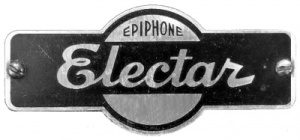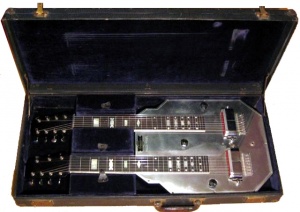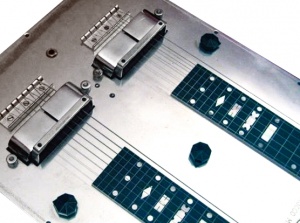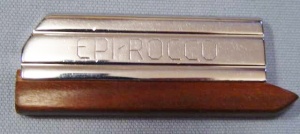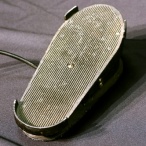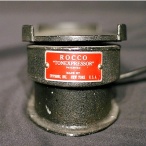Electar Rocco Lap Steel Guitar
|
Designed by the famous Hawaiian guitarist Anthony Rocco and unveiled in the May, 1936 issue of Metronome magazine, the Rocco doubleneck may very well be the first commercially manufactured electric double neck guitar. Weighing in at around 18 lbs. and with a hollow hardwood body and thick aluminum top, this seven and eight-string version must have been a bit unwieldy on the lap. The pickup magnets are 1 ¼” wide and the bobbins are wound using alternating layers of paper and wire with split bar pole pieces.
The Epi-Rooco bar was developed in conjunction with Anthony Rocco. Made from self-lubricating wood and a chrome-plated metal alloy, the Rocco Bar is designed for use on both sides. The metal side for conventional wooden instruments, and the wooden side for amplified instruments. The Rocco bar was intended to reduce the "swish" sound noticed when using other lap steel bars.
The Rocco Tone Expressor is an expression pedal which enables the player to produce various tone effects and regulate volume by foot, leaving hads free for playing. Volume regulation is obtained by a vertical rotation of the pedal. Gradual and even increase in the volume enables the steel guiarist to obtain proper shading and organ effects. Muted organ tones are produced by a horizontal rotation of the foot plate in a counter-clockwise direction. wikipedia:Double reedDouble-reed instrument type of tone for extreme high reedy effects are obtained by a horizontal rotation of the foot plate in a clockwise direction. Muted brass instrument effects are possible on the bass strings and oboe tones on treble strings. |
- 1936-1938
- Doubleneck Lap Steel Guitar
- 7 or 8-string versions
- $400 MSRP in 1939
Body:
- Hollow hardwood body
- Aluminum top
Neck:
- Rosewood fingerboard
- Dot, block & diamond ornate inlays
Binding:
- White pyralin neck binding
Electronics:
- 1 master volume & 2 tone controls
- Horseshoe magnet pickups (early versions)
- Trubalance adjustable pole-piece pickups (later versions)
Hardware:
- Bakelite carousel knobs
- Aluminum nut & bridge
- Foam pickup mutes
Includes:
- Optional Tone Expressor Pedal
- Tweed hardshell case
Colors:
- Aluminum
- Black Aluminum
Tone Expressor:
- Volume & Tone control
- Up & down for volume
- Side to side for tone
- Rubber covered cord with shielded metal plug
- Waterproof cover
- $27.50 in 1939
Electrics | Archtops | Acoustics | Basses | Bluegrass | Amplifiers | Promotional Guitars
